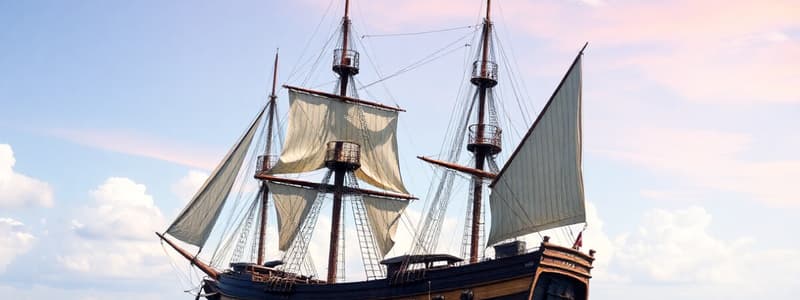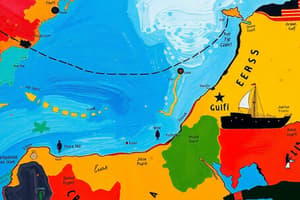Podcast
Questions and Answers
Which of the following statements accurately describes the early resistance faced by European colonists in the Americas?
Which of the following statements accurately describes the early resistance faced by European colonists in the Americas?
- Indigenous populations readily embraced European culture and technology.
- Resistance was largely passive, consisting primarily of peaceful protests and petitions.
- Indigenous groups relied on guerrilla warfare and alliances with other tribes to combat colonialism. (correct)
- European colonists faced little resistance and easily established dominance throughout the Americas.
How did the Spanish conquest of the Aztecs impact the environment?
How did the Spanish conquest of the Aztecs impact the environment?
- Extensive deforestation, soil degradation, and the introduction of new diseases disrupted the environment. (correct)
- The conquest led to the restoration of native ecosystems, as Spanish technology was more environmentally friendly.
- Spanish practices led to a more sustainable use of resources, benefiting the environment in the long run.
- The conquest had minimal environmental impact, as Spanish practices mirrored those of the Aztecs.
Which of the following was a key factor uniting the different parts of the Atlantic World?
Which of the following was a key factor uniting the different parts of the Atlantic World?
- A shared economic system, with mercantilism dominating trade and economic activity. (correct)
- A common religious belief system, with Christianity as the primary religion.
- A unified political system, with a single governing body overseeing the entire Atlantic World.
- A shared language, as Spanish and Portuguese became the dominant languages.
Why is it important to understand the environmental consequences of the conquest in the Americas?
Why is it important to understand the environmental consequences of the conquest in the Americas?
Which of the following best describes the primary goal of Spain's tributary empire in the Americas?
Which of the following best describes the primary goal of Spain's tributary empire in the Americas?
Flashcards
What is the Atlantic World?
What is the Atlantic World?
A network of interactions and exchanges that connected Europe, Africa, and the Americas across the Atlantic Ocean, shaping political, economic, and cultural landscapes.
The Portuguese in Africa
The Portuguese in Africa
The Portuguese established trading posts and forts along Africa's western coast, engaging in the lucrative slave trade, ultimately impacting African societies and the transatlantic slave trade.
Columbus Arrives in Americas
Columbus Arrives in Americas
Columbus' voyages, although aiming for Asia, landed him in the Americas, initiating European colonization and disrupting indigenous societies, marking the beginning of a new era in global history.
First Encounters w/ Natives
First Encounters w/ Natives
Signup and view all the flashcards
Spanish Conquest/ Invasion of Aztecs
Spanish Conquest/ Invasion of Aztecs
Signup and view all the flashcards
Study Notes
European Exploration (1420-1580)
- Direct link between political centralization and trade revival due to monarchies (power in one person).
- Religious consolidation (expulsion of non-Catholics).
- Trade with Southwest Asia.
- Renaissance emerged from these locations, leading to economic and cultural booms.
- Most powerful European kingdoms had resources to build armies, ships, and new technologies (like the compass).
The Portuguese in Africa
- Africa became a valuable trading source for gold, sugar, and labor.
- Ports and fortresses were built along the West African coast.
- First sugar plantations were established.
- Portuguese established colonies on the Madeira, Canary, and Cape Verde archipelagos.
- They used African slaves for labor.
- Plantation slavery modeled the New World economy.
Spain and Columbus
- Political and religious divisions within Spain (different dynasties, Moors, Christians, Jews).
- Unification of Isabella of Castille and Ferdinand of Aragon (1469).
- Significance of 1492:
- Inquisition
- Moors gaining strength in Europe
- Forced conversions of Jews and Muslims to "conversos"
- Defeat of last Muslim stronghold, Granada
- Forcing expulsion of Jews from Spain
- Chartering Christopher Columbus.
- First publication of a Spanish-language grammar.
Columbus's Arrival in the Americas
- October 12, 1492, Columbus landed in the Bahamas (on behalf of Spain).
- Columbus aimed to make money and spread Christianity.
- Claimed Hispaniola, Haiti, and the Dominican Republic.
- The Spanish established colonial rule; a model for other areas.
First Encounters with Natives
- Columbus mistook the Tainos for "Indians."
- Believed the Tainos were child-like and ready for conversion.
- Europeans were seen as god-like or monsters, depending on the Indigenous perspective.
- Europeans had advanced weaponry, ships, and organization.
- Indigenous populations had limited knowledge of European technologies.
Early Resistance to Colonialism
- Indigenous resistance and rebellion were common.
- Spaniards responded by enslaving Indigenous people (encomiendas).
- Indigenous labor was essential for gold and other resources, though it often led to their death.
- The vast majority of the Indigenous populations succumbed to European diseases.
Great American Civilizations
- Aztecs:
- Tenochtitlan conquered surrounding city-states.
- Cyclical time and life cycle, blood sacrifices for fertility and survival
- Sophisticated social structure (nobles, warriors, priests, etc.).
- How do we know about them? Codieces (pictorial histories)
- Incas:
- Andes (Peru, Bolivia, Ecuador)
- Mountainous terrain was a benefit to their organization
- Important for conquest
Spanish Conquests
- Conquistadors like Hernán Cortés and Francisco Pizarro.
- Conquests resulted from cultural misunderstandings, superior weaponry, and disease.
- Indigenous empires (Aztecs and Incas) were drastically weakened during conquest.
Environmental Consequences
- Columbian Exchange: the exchange of ideas, agriculture, animals, slaves, etc.
- European diseases (like smallpox, measles, influenza) decimated the Indigenous populations (up to 90%).
- New forms of agriculture emerged (like corn, potatoes, tomatoes).
- Agricultural exchanges between the "Old World" and "New World" were significant.
Spain's Tributary Empire
- Spanish used existing economic systems and indigenous hierarchies.
- Silver was a crucial resource.
- Racial mixing between Spaniards and Indigenous people.
- Religious syncretism (blending of Catholicism and Indigenous practices).
Early Christianity
- Father de Montesinos questions the treatment of Indigenous people.
Studying That Suits You
Use AI to generate personalized quizzes and flashcards to suit your learning preferences.




